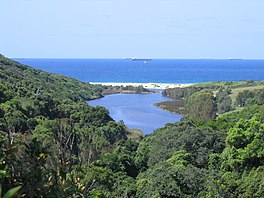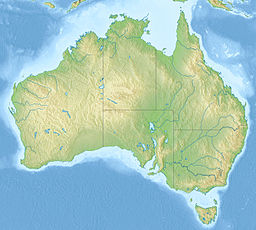
The City of Lake Macquarie is a local government area in the Hunter Region in New South Wales, Australia. It was proclaimed a city from 7 September 1984. The city is situated adjacent to the city of Newcastle and is widely considered as a part of the Greater Newcastle area. The city is approximately 150 km (93 mi) north of Sydney. One of its major tourist attractions is its lake, also named Lake Macquarie.

The Great North Walk is a walking track which runs from Sydney to Newcastle in New South Wales, Australia. The main track, 250 kilometres (160 mi) in length, runs between the Obelisk in Macquarie Place in Sydney to Queens Wharf in Bicentennial Park in Newcastle and is well sign-posted. There are many "side tracks" which link the track to populated areas along the length of the walk. The walk includes a huge variety of wildlife and scenery.
Charlestown is a suburb of the City of Lake Macquarie, New South Wales, Australia, and the largest suburb in Lake Macquarie and in the Greater Newcastle area. It is approximately 10 kilometres (6 mi) west-south-west of the central business district of Newcastle.

Belmont is a suburb in the City of Lake Macquarie New South Wales, Australia, located 20 kilometres (12 mi) from Newcastle's central business district on the eastern side of Lake Macquarie.
Kahibah is a suburb of the City of Lake Macquarie, Greater Newcastle in New South Wales, Australia, located 9 kilometres (6 mi) from Newcastle's central business district.

The Belmont railway line is an abandoned coal haulage and passenger rail line from Adamstown, New South Wales to Belmont, New South Wales. This was a private railway, being the property of the New Redhead Estate and Coal Company and was generally known as the Belmont Branch. The line closed in December 1991. It has since been converted into a cycleway or rail trail - The Fernleigh Track.
New Lambton is a suburb of Newcastle, in the Hunter Region of New South Wales, Australia. It is located about 6 km (4 mi) west of the Newcastle central business district. It includes two shopping districts, schools and other general facilities. At the 2016 Australian census it had a population of approximately 10,000.
Charlestown is an electoral district of the Legislative Assembly in the Australian state of New South Wales. It has been represented by Jodie Harrison of the Labor Party since the Charlestown by-election on 25 October 2014.

The Australian Agricultural Company (AACo) is a public-listed Australian company that, as of 2018, owns and operates feedlots and farms covering around seven million hectares of land in Queensland and the Northern Territory, roughly one percent of Australia's land mass. As of July 2008 AACo had a staff of 500 and operated 24 cattle stations and two feedlots, consisting of over 565,000 beef cattle.

Merewether is a former Municipality and today a suburb of Newcastle, New South Wales, Australia, located 3 km (2 mi) from Newcastle's central business district with a population of around 11,000. The suburb stretches 3 km (2 mi) from Merewether Beach in the east to Adamstown in the west.

Lake Macquarie is Australia's largest coastal lagoon. Located in the City of Lake Macquarie and Central Coast Council local government areas in the Hunter and Central Coast regions of New South Wales, Australia, it covers an area of 110 square kilometres (42.5 sq mi) and is connected to the Tasman Sea by a short channel. Most of the residents of the City of Lake Macquarie live near the shores of the lagoon.
Adamstown is a suburb of Newcastle, New South Wales, Australia, located 6 kilometres (4 mi) from Newcastle's central business district. It is split between the City of Newcastle and City of Lake Macquarie local government areas.

The City of Newcastle is a local government area in the Hunter region of New South Wales, Australia. The City of Newcastle incorporates much of the area of the Newcastle metropolitan area.
Adamstown Heights is a southern suburb of Newcastle, New South Wales, Australia, located 8 kilometres (5 mi) west-southwest of Newcastle's central business district along the Pacific Highway. It is split between the City of Lake Macquarie and City of Newcastle local government areas. On 6 September 1991 Adamstown heights officially become a suburb of Newcastle.

Seahampton is a hamlet situated north of West Wallsend, New South Wales, Australia, located 21 kilometres (13 mi) west of the city of Newcastle's central business district and west of the Sydney-Newcastle Freeway. It is a suburb of the City of Lake Macquarie local government area.
The South Waratah Colliery was a coal mine located at Charlestown, in New South Wales Australia.

The Fernleigh Track is a multi-use rail trail near Belmont in New South Wales. The track was constructed in the way of the former Belmont railway line. The project is a joint venture between Newcastle City Council and City of Lake Macquarie. The track extends from Adamstown to Belmont over an approximate distance of 15.5 km (10 mi). The former railway closed in December 1991. The first section between Adamstown and Burwood Road opened in 2003. Construction has continued in stages with the final section between Jewells and Belmont completed in March 2011.
John Julius Thomas Stewart was an Australian politician. He was a Labor Party member of the New South Wales Legislative Assembly from 1957 to 1972, representing the electorates of Kahibah (1957–71) and Charlestown (1971–72).














